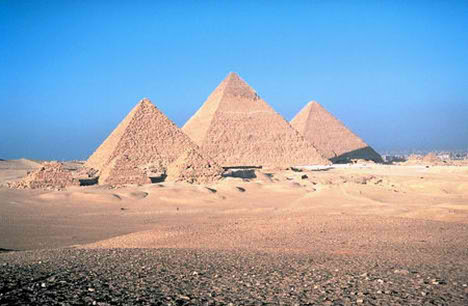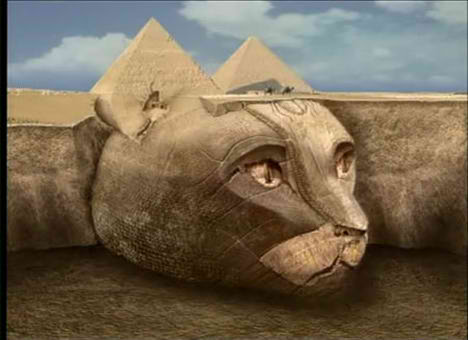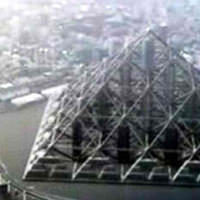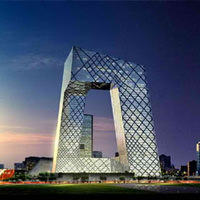
Past theories have suggested that builders on Egypt’s Giza Plateau build the pyramid’s using an external ramp, some say the ancient Egyptian has seek help from aliens using UFO to move those big blocks of stones. French architect Jean-Pierre Houdin has a new theory.
What if the pyramid had been built from the inside out?
Twentieth year of the reign. The pyramid seen from another angle. The main construction is finished, the pyramidion is in place on the summit. Finishing work is about to start from the summit down.
According to French architect Jean-Pierre Houdin, the 4,500-year-old tomb of Pharaoh Khufu was built using a ramp that spirals around the pyramid’s interior 30 to 45 feet (nine to 14 metres) behind the exterior surface.
Building the Pyramid on an even level terrain
What the ancient Egyptians did was dig a trench between the two stakes and then fill it with water. The water would “seek its own level” and they would measure up from the water level.
Watch the 3D Video for a better understanding of the new theory. More information at DailyIndia.






Ramps for Giza Pyramid constructions are not mentioned in ancient Egyptian records but wooden machines are. These machines do not require ramps, but do require steps. The Giza Pyramids have four stepped sides as we can see, as many outer casing blocks have been removed. Ramps are a modern invention because the ancient records are considered to be unbelievable by modern academia. My own research proves beyond all doubt the ancient Egyptian records to be absolutely correct and I have written and published a book about my findings titled “Raising Stone 1: Paul Hai’s racks & pinions theory” published in 2007. In this high quality illustrated book Giza Pyramid construction is fully explained.
Please visit my website at http://www.haitheory.com
Rampless Egyptian Pyramid construction has a definite AUSTRALIAN connection
Captain Matthew Flinders navigated and mapped Australia’s coastline. His grandson became Professor Sir William Matthew Flinders Petrie who excavated ancient Egyptian artifacts. In 1895 as an employee of the Egypt Exploration Fund (now Society) of London he was excavating artifacts at Deir el-Bahari and found a cache of ancient building equipment buried for preservation in a hewn out rock pit during Pharaonic times.
One of the wooden items is stated as being of “unidentified use” and has been named the “Petrie rocker” by Egyptologists.
Petrie considered the “rocker” was used to raise Pyramid blocks with a “rocking” motion and in 2006 he has been proven partly correct on the matter of raising Pyramid blocks using “rockers”.
The “rocker” is a component of an ancient Egyptian pulley which operates with a mechanical advantage of 2.8 and with CLASS 2 lever principle as a wheelbarrow does. (CLASS 2 lever: Pivot – Load – Effort).
The technical term for the “Petrie rocker” is “pinion-pulley lobe quadrant”. Four of these surround a Pyramid block and then the pulley is hoisted causing rotation and positive engagements of pulley lobes with Pyramid steps.
Consider the Pyramid as four RACKS of stone teeth on to which the PINION pulley lobes engage and here is the earliest form of RACK & PINION mechanics that we know of.
This is the ancient method of Pyramid construction as used on at least four large Pyramids: Sneferu’s RED Pyramid and those at Giza of Khufu, Khafre and Menkaure.
This ancient method of construction DOES NOT REQUIRE RAMPS and uses the Pyramid under construction (using all four sides simultaneously) to complete the Pyramid, thus using a Pyramid to build a Pyramid.
Petrie died in Jerusalem in 1942 unknowing that “Petrie rockers” are components of an ancient pulley, unlike any pulley in the modern world, hitherto unknown and one of his most important excavations.
Here are a few videos that should peak your interest in what I have to say on the subject.
The Mystery of the Stone Quarries
Winds of Egypt Not Copper Tools
Boats over the Pyramids
And the links to the commentary blog posts.
http://thelockedgates.blogspot.com/2011/06/mystery-of-stone-quarries.html
http://thelockedgates.blogspot.com/2011/06/aten-god-of-solar-energy_01.html
http://thelockedgates.blogspot.com/2011/06/how-pyramids-were-built.html
Howard West
One of the biggest events of the ancient world was the construction of the Giza Pyramids.
Ezekiel writes of machines thus, “their rims were high and awesome, and all four rims were full of eyes all around.” A Pyramid block with pulleys fitted is about one metre wide and one and a half metres high. When numerous pulleys were ascending the Pyramid during the cool of night by firelight, the scene would certainly be high and awesome. Ezekiel writes of what appears to be the lifting devices used to fit the pulley which he writes are straight with a calf shaped foot made of bronze. These devices are known as “claw lifts” and are fully explained in the book, RAISING STONE 1. I suspected the claw lifts were made of timber and their feet strengthened with bronze plates. There is no need to consider Ezekiel mentally sick and there is no need to entertain any ideas of UFO’s and aliens. The building of the Pyramids was a dramatic event of ancient times using the latest technology involving machinery. This machinery was designed and manufactured by MAN, and having the strength of an OX, could soar like an EAGLE and leap like a LION. The four faces are the associated attributes of the machinery itself. The CHERUBS are the pulleys climbing as if alive and their WINGS are the pulley lobes which touch each other as they are tied together around a beryl coloured sandstone block to be part of the THRONE. The THRONE is the Pyramid. The NOISE and WHIRLWIND refer to much activity onsite at Giza. (This ancient bible documented report is dated c.590 BC)
I need to be specific about … “and all four rims were full of eyes all around”.
Ezekiel’s reference to “eyes all around” is how the cross-pegs (for the rope) appear on the outer faces of the four pinion-pulley’s lobes.
These “eyes” are adjacent the four rims of the four pinion-pulley lobes and so are “all around”.
These “eyes” are, to be specific, the round flat ends of the cross-pegs.
These end pegs were more than likely enhanced with paint to give animal’s eyes appearance, to bestow animal qualities to the pinion-pulleys operation. (Bird’s eyes for flight, lion’s eyes for power and so forth).
There are today only two ancient documents related to ancient Egyptian Pyramid construction at Giza.
“Ezekiel’s vision” and information given to Herodotus of Halicarnassus (The Greek Father of History) c.450 BC by his counterparts at Giza who were the historian priests as the ancient priesthood were literate and it is they who recorded history that was Egypt’s concern and interest.
For instance Egyptian priests recorded the devastating eruption of the Thera (Kalliste) volcano which occurred 1627-1600 BC as this event caused horrific events in Egypt and caused the declining Minoan (Kalliste) Maritime Empire, Egypt’s trading partner, an accelerated decline.
Ezekiel’s “vision” is a firmly established real event which has been much talked about for years in the Middle East.
Priest Ezekiel at Babylon, would have heard accounts from relatives of people who had been employed by Pharaoh Khufu’s administration and/or the administration of Khafre and Menkaure.
Ezekiel’s account may lack the technical language we take for granted, but knowing the subject of his “vision” gives us an insight into the quaintness of ancient language.
References to animals was part of the ancient world in language and in artifacts.
“He’s as strong as an ox, fights like a lion and can run like a cheetah”.
Ancient furniture legs have animal feet, paws and claws and arm-rests have animal paws and claws for instance.
This tradition has continued into modern times, but today we have technical language available to us when we want to be clear and precise.
Thanks for taking the time to study my work.
Ezekiel’s vision is solved by accident however.
Firstly, I had to discover how 2.3 million blocks of stone were raised in just twenty years (historically documented) for construction of Khufu’s Great Pyramid.
Rampless Pyramid construction was realised during university research on the Sunday afternoon of 27 August 2006.
The pinion-pulley lobes are known by many people as “Petrie rockers” after William Matthew Flinders Petrie was handed one in 1895 for his Petrie museum in London. This “rocker” was found at Deir El Bahari in the temple complex of Pharaoh Hatshepsut and bears the cartouche of the woman Pharaoh Hatshepsut which translates as “Elegant Lady”.
The lobed components when fitted around a block of stone do NOT form a wheel but a four lobe array or as I began to realise, “wheels within wheels” and found myself reading and studying Ezekiel’s vision over and over for hours.
How else could a person describe a LOBE in 590 BC ?
“Wheels within wheels” is referring to the four lobes as fitted around a Pyramid block.
Some readers will be asking if The Great Pyramid could have been built within twenty years as historical documents state?
Let us suppose ten of these “wheels within wheels” wooden machines were operating on each side of the Pyramid, so there were forty “wheels within wheels” wooden machines at work back in 2500 BC.
The workers were NOT slaves, so let them have an eight hour day (or the cool of night, working by torch-light) and let them raise one block per machine to its place per hour.
The daily work of forty “wheels within wheels” wooden machines raises 320 blocks per day.
With 365 days in a year this is 116,800 blocks raised per year and in twenty years Khufu’s Great Pyramid has been completed with an estimated 2,336,000 blocks being raised and placed.
Ramps are NOT mentioned in any historical documents relating to Giza Pyramid construction and all ramp theories are modern and not related to real ancient history. All ramp theories become null and void anyway due to the fact that 2.3 million blocks of stone had to be placed within twenty years, so ramp theorists have stated Greek historian Herodotus was a liar and Egyptian historian priests did not know what they were talking about … and there was a mix-up with the translation from Egyptian to Greek. Most of these ramp theorists people are highly paid experts (ex-spurts) who have made documentary films and written their lies into books. You all know who they are.
When we read of men having clawed feet or a calf’s foot this is not about deformed people or aliens.
This has to be interpreted as men carrying or working with clawed feet apparatus or the apparatus has a calf’s foot shaped attachment.
There are two centrally edge located notches cut out in the base of many Pyramid blocks where these attachments were placed for lifting the blocks so the opened and laid flat pinion-pulley lobes, like an open bracelet, could be pulled underneath, wrapped around a Pyramid block and closed, making it ready for its step-walk upward on the Pyramid’s steps.
These lifting devices are known as claw-lifts. (Reference the Ersnt von Sieglin German expedition of 1909-1910)